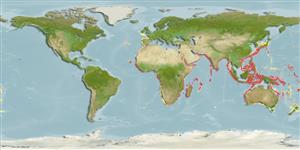>
Perciformes/Bembropoidei (Duckbill flatheads) >
Bembropidae (Duckbill flatheads)
Etymology: Bembrops: Greek, bembras, -ados = a kind of anchovy m+ Greek, ops = appearance (Ref. 45335); caudimacula: Specific name from the Latin 'cauda' meaning tail and 'macula' meaning spot or stain, referring to the dark spot on the caudal fin..
More on author: Steindachner.
Environment: milieu / climate zone / depth range / distribution range
Ecologia
marinhas batidemersal; intervalo de profundidade 186 - 500 m (Ref. 13203). Deep-water
Indo-West Pacific: Japan and Korea, south to Borneo and northeastern Australia, west to the Andaman Sea and Indian Ocean, and in the Gulf of Aden. Eastern Atlantic: only in the Gulf of Guinea.
Tamanho / Peso / Idade
Maturity: Lm ? range ? - ? cm
Max length : 24.1 cm TL macho/indeterminado; (Ref. 115021); peso máx. Publicado: 94.00 g (Ref. 115021)
Espinhos dorsais (total): 6; Raios dorsais moles (total): 14-15; Raios anais moles: 16. Anterior portion of first dorsal fin darkish. Usually 6 scale rows between lateral line and origin of anal fin (Ref 12932).
Life cycle and mating behavior
Maturidade | Reprodução | Desova | Ovos | Fecundidade | Larvas
Das, M.K. and J.S. Nelson, 1996. Revision of the percophid genus Bembrops (Actinopterygii: Perciformes). Bull. Mar. Sci. 59(1):9-44. (Ref. 13203)
Categoria na Lista Vermelha da IUCN (Ref. 130435)
Ameaça para o homem
Harmless
Utilização humana
Mais informação
Nomes comunsSinónimosMetabolismoPredadoresEcotoxicologiaReproduçãoMaturidadeDesovaAgregação para desovaFecundidadeOvosDesenvolvimento dos ovos
ReferênciasAquaculturaPerfil para aquaculturaEstirpesGenéticaElectrophoresesHereditariedadeDoençasProcessamentoNutrientsMass conversion
Ferramentas
Relatórios especiais
Descarregue XML
Fontes da internet
Estimates based on models
Preferred temperature (Ref.
123201): 11 - 18.6, mean 13.1 °C (based on 226 cells).
Phylogenetic diversity index (Ref.
82804): PD
50 = 0.5000 [Uniqueness, from 0.5 = low to 2.0 = high].
Bayesian length-weight: a=0.00309 (0.00180 - 0.00531), b=3.07 (2.92 - 3.22), in cm total length, based on LWR estimates for this species & (Sub)family-body (Ref.
93245).
Nível Trófico (Ref.
69278): 4.0 ±0.4 se; based on size and trophs of closest relatives
Fishing Vulnerability (Ref.
59153): Low vulnerability (14 of 100).
